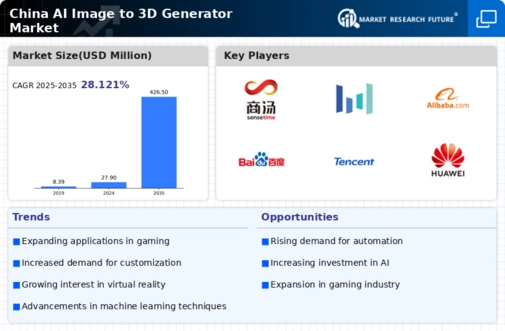Growing E-commerce Sector
The expansion of the e-commerce sector in China significantly influences the ai image-to-3d-generator market. With online shopping becoming increasingly popular, retailers are seeking innovative ways to enhance customer experience. 3D product visualization allows consumers to view items from multiple angles, thereby improving engagement and reducing return rates. According to recent data, the e-commerce market in China is expected to reach over $2 trillion by 2025, driving demand for advanced visualization tools. This growth presents a substantial opportunity for the ai image-to-3d-generator market, as businesses invest in technologies that facilitate immersive shopping experiences. The ability to create realistic 3D models from images can provide a competitive edge, making it a crucial component of e-commerce strategies.
Technological Advancements in AI
The rapid evolution of artificial intelligence technologies is a primary driver for the ai image-to-3d-generator market. In China, advancements in machine learning algorithms and neural networks enhance the capabilities of these generators, allowing for more accurate and efficient 3D model creation. The integration of AI with computer vision techniques enables the transformation of 2D images into detailed 3D representations, which is particularly valuable in sectors such as architecture and product design. As a result, the market is projected to grow at a CAGR of approximately 25% over the next five years, reflecting the increasing reliance on AI-driven solutions in various industries. This trend indicates a strong potential for innovation and investment in the ai image-to-3d-generator market, as companies seek to leverage these advancements to improve their offerings.
Demand for Enhanced User Experience
The pursuit of enhanced user experience across various platforms is a critical driver for the ai image-to-3d-generator market. In China, businesses are increasingly recognizing the importance of providing immersive and engaging experiences to their customers. This trend is particularly relevant in sectors such as real estate, where virtual tours and 3D visualizations can significantly impact consumer decisions. Companies are investing in technologies that allow for the seamless integration of 3D models into their marketing strategies. As a result, the ai image-to-3d-generator market is likely to experience growth as businesses seek to differentiate themselves through innovative user experiences. The emphasis on user engagement suggests a promising future for the market, with potential increases in demand for advanced 3D generation tools.
Rising Interest in Education and Training
The ai image-to-3d-generator market is also being propelled by the growing interest in education and training programs that incorporate 3D modeling. In China, educational institutions are increasingly integrating technology into their curricula, emphasizing the importance of digital skills. The use of ai image-to-3d-generators in educational settings allows students to engage with complex concepts in a more interactive manner. This trend is particularly evident in fields such as engineering, design, and architecture, where hands-on experience with 3D modeling tools is essential. As educational institutions invest in these technologies, the market is expected to see a rise in adoption rates. This could lead to a broader acceptance of ai image-to-3d-generators in various sectors, further driving market growth.
Increased Investment in Creative Industries
China's creative industries are witnessing a surge in investment, which is positively impacting the ai image-to-3d-generator market. As sectors such as film, animation, and gaming continue to grow, there is a heightened demand for high-quality 3D content. The government has recognized the importance of these industries and is providing support through funding and policy initiatives. This environment fosters innovation and encourages the adoption of advanced technologies, including ai image-to-3d-generators. The market is likely to benefit from this trend, as creative professionals seek tools that streamline their workflows and enhance the quality of their outputs. The increasing focus on content creation is expected to drive market growth, with projections indicating a potential increase in market size by 30% over the next few years.

















Leave a Comment